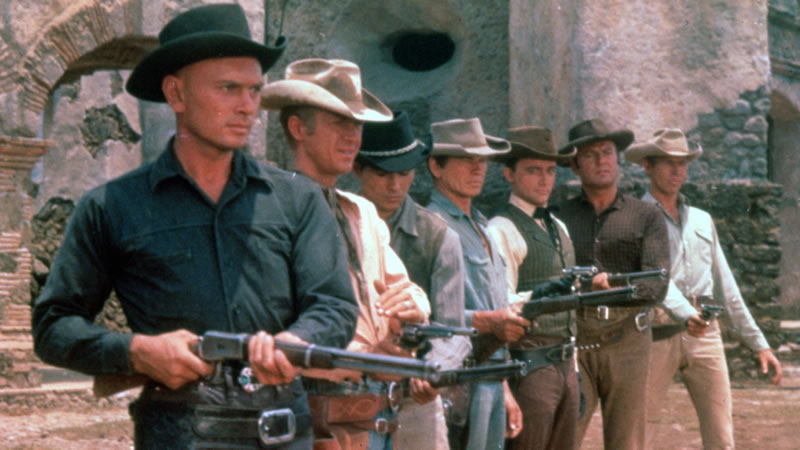All three Magnificent Seven movies are a great time and bring something to the table.
The basic plot for all three versions is that a small, poor village is periodically being raided by a large group of bandits. They get fed up and decide to hire seven skilled warriors, all of whom decide to join in their cause for one reason or another.
All three movies also star A-list actors in their prime.
The original film is Seven Samurai, directed by Akira Kurosawa and stars Toshiro Mifune, Takashi Shimura, Daisuke Kato, Isao Kato, Isao Kimura, Minoru Chiaki, and Seiji Miyaguchi as the titular samurai.
The movie itself was released in 1954 and is in black and white. The film itself is also in Japanese with English subtitles.
This movie is a classic for a reason. At a lengthy three hours, this film has the feel of an ancient epic one would pass down from generation to generation.
The film’s fights don’t feel like choreography; they feel like an actual battle. Meaning they feel raw, uncoordinated; they roll around in the mud just trying to kill the other guy.

This is in contrast to how the samurai fight in the film. Their fight style is fluid, thought out, using large strokes to take out an enemy with one strike. The film also shows how skilled they are with a blade by the fact that whenever one of the samurai is killed, they’re not killed with a blade but are instead shot from afar with a rifle.
The film is also deeper than one might think. The samurai are arrogant and look down on the villagers as scavengers and cowardly.
This comes to a head when one of the samurai (Mifune), who grew up in a poor village similar to one they’re protecting, yells at his comrades, telling them that the only reason that villagers are like this is because of the samurai. The needless war between the clans had forced the villagers to become scavengers and cowards.
This outburst to the arrogant samurai is a direct comment to the Japanese government at the time. The film was released after the end of World War II and the dropping of nuclear bombs on Hiroshima and Nagasaki.
The needless wars between the clans are similar to the old government’s need to expand Japan. And the dishonorable way the villagers act is similar to how the Japanese people were forced to suffer because of all the expansion.
One of the few problems the film has is that about half of the samurai either don’t really do much or don’t have much of a character aside from their introduction.
The villain (Shinpei Takagi) is also not particularly deep; he’s just the leader of the bandits and that’s it. Aside from him wearing an eyepatch there’s nothing to distinguish him from the other bandits in the film.
If you have a problem with subtitles, it might be better to watch the 1960 remake.
Seven Samurai was one of the highest grossing films in Japan, and still makes lists of the best films ever made. Hollywood saw fit to remake the film under the title The Magnificent Seven.
The film was directed by John Sturges. It starred Yul Brynner, Steve McQueen, Horst Buchholz, Charles Bronson, Robert Vaughn, Brad Dexter and James Coburn as the seven gunslingers.
Instead of the seven having to rely on their swordsmanship, this group of seven relies on shooting skills.
In this film the setting becomes a small Mexican village, with the villagers having to hire seven gunslingers from across the border.
However it is still a very loyal adaptation and in some ways is better than the Japanese original.
Starting off, the characters have a much better rapport with each other, with most of them working really well off each other in comedic and dramatic ways.
The heroes are also more pronounced, with all of them dressing and acting very differently.
The villain in this film is also better than the original. As the bandit leader, Eli Wallach is charismatic, funny, and actually seems to care about his men.
With that being said, the original Seven Samurai did do some things better.
In the original film the fights felt raw and real. While in the 1960s version it feels a bit more choreographed and staged. Not to say that the fight scenes are bad, they’re not, but the original fight scenes were just better.
That is not a problem in the 2016 remake directed by Antoine Fuqua. It stars Denzel Washington, Chris Pratt, Ethan Hawke, Vincent D’Onofrio, Lee Byung-Hun, Manuel Garcia-Rufio, and Martin Sensaimer.
Starting right off the bat, the action in this movie is the best out of the three.
In this film it feels like a war, with bullets flying everywhere, fires raging, and everyone trying to keep their heads down to not get shot.
The characters also have different skills and roles that further differentiate them from each other. One’s a sniper, one’s really good with knives, one’s the tracker, another is really good with explosives, and so on.
This comes at a cost as the characters in this version aren’t as deep as they were in the two previous films.
It’s well acted and entertaining, but instead of coming off as people who are doing this dangerous task for their own personal reasons, they instead come off as a gimmick.
The villain (Peter Sarsgaard) in this version is slimier than his counterparts, apparently willing to do whatever is necessary to get what he wants, with no line he isn’t willing to cross. But he, like the heroes, is entertaining but not particularly deep.
No matter which of these films you pick, you’re in for a good time. The original is down to earth and interesting; the 1960 version has some of the best characters, and the 2016 version has the best action.
Patrick Pugh is a writer for the Thunderword.

